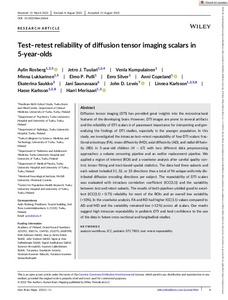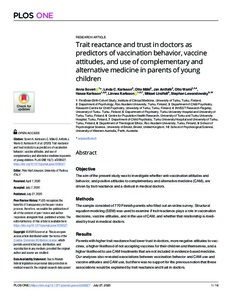Hae
Aineistot 21-30 / 52
Children's diurnal cortisol output and temperament in two different childcare settings at 2 and 3.5 years of age
<p>Prior research suggests that child temperament may play an important role in early childhood stress regulation. We compared children's diurnal cortisol and the association between cortisol and temperament in two different childcare settings. Cortisol was measured from saliva samples over 2 days in children (N = 84) attending out-of-home childcare and in children (N = 27), who were cared for at home at the age of 3.5 years. There was no difference between the childcare groups in total diurnal cortisol. However, of the individual measurements, afternoon cortisol levels were higher in the out-of-home childcare group during their childcare day when compared with their home day. Child temperament was not associated with total diurnal cortisol. Comparison with our prior measurements showed that the association between temperamental surgency/extroversion and total diurnal cortisol diminished along with the child age from 2 to 3.5 years in both childcare settings. This may indicate that more extroverted children are physiologically more reactive to environmental stimuli when they are younger, but this association does not appear as the children develop. Our results further suggest that the afternoon hours in the out-of-home childcare may be demanding and accelerate the hypothalamus–pituitary–adrenal axis activation in young children independent of their age.<br></p>...
The role of alexithymia and perceived stress in mental health responses to COVID-19: A conditional process model
<p><strong>Background</strong><br>Little is known about the psychological mechanisms underlying the mental health problems related to the COVID-19 pandemic. Hypothetically, perceived stress and alexithymia may be factors ...
Prenatal and early-life environmental factors, family demographics and cortical brain anatomy in 5-year-olds: an MRI study from FinnBrain Birth Cohort
The human brain develops dynamically during early childhood, when the child is sensitive to both genetic programming and extrinsic exposures. Recent studies have found links between prenatal and early life environmental ...
Sex‐specific role of alexithymia in associations between parental bonding and mental health: A moderated mediation model
<p><strong>Objective: </strong>This study aimed to explore the role of alexithymia and potential sex differences in the associations between perceived parental bonding and mental health.</p><p><strong>Methods: </strong>The ...
Hair Cortisol Concentrations Are Associated with Dental Anxiety during Pregnancy
Dental anxiety (DA) and hair cortisol concentrations (HCC) are associated with psychological symptoms and vary during pregnancy. We aimed to examine the association between HCC and DA at two points of pregnancy. Participants ...
The factorial structure of the Hong Psychological Reactance Scale in two Finnish samples
<p>Psychological assessment scales need to be psychometrically sound, but previous
research on the factorial structure of one of the most common measures of trait
reactance, the Hong Psychological Reactance Scale (HPRS), ...
Test-retest reliability of diffusion tensor imaging scalars in 5-year-olds
Diffusion tensor imaging (DTI) has provided great insights into the microstructural features of the developing brain. However, DTI images are prone to several artifacts and the reliability of DTI scalars is of paramount ...
Trait reactance and trust in doctors as predictors of vaccination behavior, vaccine attitudes, and use of complementary and alternative medicine in parents of young children
<p>
</p><p><b>Objective:</b> The aim of the present study was to investigate
whether anti-vaccination attitudes and behavior, and positive attitudes to
complementary and alternative medicine (CAM), are driven by trait ...
A variation in the infant oxytocin receptor gene modulates infant hippocampal volumes in association with sex and prenatal maternal anxiety
Genetic variants in the oxytocin receptor (OTR) have been linked to distinct social phenotypes, psychiatric disorders and brain volume alterations in adults. However, to date, it is unknown how OTR genotype shapes prenatal ...
Infant fecal microbiota composition and attention to emotional faces
The gut microbiota has been suggested to influence neurodevelopment in
rodents. Preliminary human studies have associated fecal microbiota
composition with features of emotional and cognitive development as well
as differences in thalamus-amygdala connectivity. Currently,
microbiota-gut-brain axis studies cover heterogenous set of infant and
child brain developmental phenotypes, while microbiota associations with
more fine-grained aspects of brain development remain largely unknown.
Here (N = 122, 53% boys), we investigated the associations
between infant fecal microbiota composition and infant attention to
emotional faces, as bias for faces is strong in infancy and deviations
in early processing of emotional facial expressions may influence the
trajectories of social-emotional development. The fecal microbiota
composition was assessed at 2.5 months of age and analyzed with 16S rRNA
gene sequencing. Attention to emotional faces was assessed with an
age-appropriate face-distractor paradigm, using neutral, happy, fearful,
and scrambled faces and salient distractors, at 8 months of age. We
observed an association between a lower abundance of Bifidobacterium and a higher abundance of Clostridium
with an increased “fear bias,” that is, attention toward fearful versus
happy/neutral faces. This data suggests an association between early
microbiota and later fear bias, a well-established infant phenotype of
emotionally directed attention. However, the clinical significance or
causality of our findings remains to be assessed....









